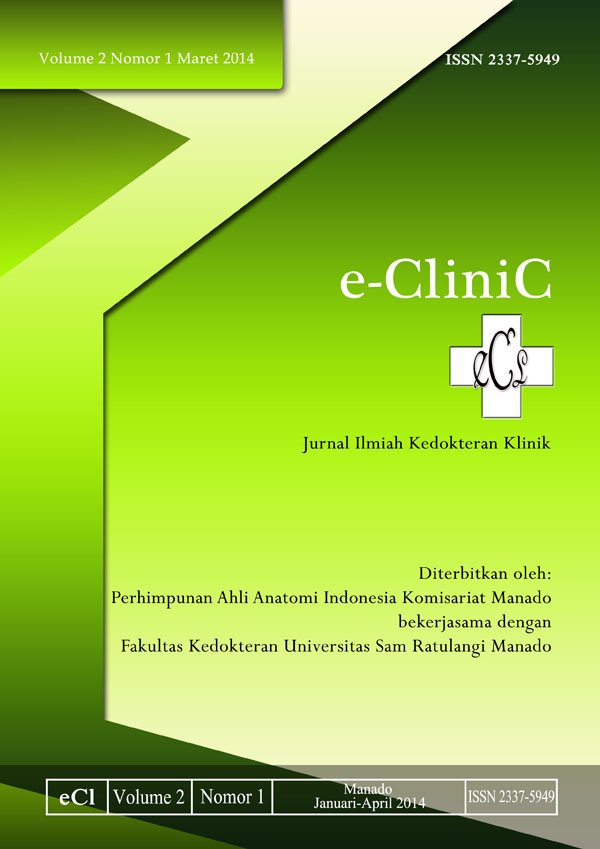ANALISIS KADAR KREATININ PADA ANAK DENGAN LEUKEMIA LIMFOBLASTIK AKUT DI PUSAT KANKER ANAK ESTELLA BLU RSUP PROF DR RD KANDOU
DOI:
https://doi.org/10.35790/ecl.v2i1.3662Abstract
Abstract: Malignant disease in children is one cause of death in the age group of children. Characteristic of the spread and prognosis of malignancy in children is very different with malignancy in adult. Acute Lymphoblastic Leukemia is the most common malignancy in children. Treatment with chemotherapy gifts a good effect in recent years, characterized by a decrease in mortality. How ever, as a vital organ that has function to stabilizer and organ disposal of substances that are not useful and toxic, surely chemotherapy effect on the health of kidney function. The impact of chemotherapy on renal function can be determined by examination of creatinne levels in children undergoing chemotherapy. The purpose of this study is to determine the levels of creatinine in children with acute lymphoblastic leukemia undergoing therapy in Estella Room BLU RSUP Prof Dr RD Kandou Manado. Characteristic of this study is descriptive analytic with retrospectional approach, this case done by taking patient’s medical record data from September 2012-2013. Samples were 30. Conclusion:The result obtained from 30 samples contain as many as 16 samples had normal creatinine levels, and 14 samples had not normal creatinine levels, which consisted of 15 samples with a high risk group, an 15 sample with standard risk group. Bivariat analysis result show the value of P=0.642. From this result, it can be concluded that there is no differences between creatinine levels in children with high risk group and children with standard risk group.
Keywords: Acute Lymphoblastic Leukemia, Creatinine, Child
Â
Â
Abstrak:Penyakit keganasan pada anak merupakan salah satu penyebab utama kematian pada kelompok umur anak.Kanker pada anak sangat berbeda dengan keganasan pada orang dewasa dalam sifat, penyebaran dan prognosis.Leukimia Limfoblastik Akut merupakan keganasan yang paling sering terjadi pada anak.Penanganan dengan kemoterapi memberikan efek yang baik dalam beberapa tahun terakhir, ditandai dengan penurunan angka mortalitas.Namun sebagai organ vital yang memiliki fungsi sebagai pengatur keseimbangan dan organ pembuangan zat-zat yang tidak berguna serta bersifat toksik, tentunya kemoterapi memberikan efek terhadap kesehatan fungsi ginjal. Dampak kemoterapi terhadap fungsi ginjal dapat diketahui dengan pemeriksaan kadar kreatinin pada anak yang menjalani kemoterapi. Tujuan penelitian ini untuk mengetahui kadar kreatinin pada anak dengan leukemia limfoblastik akut yang menjalani terapi di Ruang Estella BLU RSUP Prof. DR. R.D Kandou.Penelitian ini bersifat deskriptif analitik dengan pendekatan retrospektional, dalam hal ini dilakukan dengan pengambilan data rekam medik pasien sejak September 2012-2013. Sampel berjumlah 30 orang. Simpulan : Hasilyang didapatkan dari 30 orang sampel, terdapat sebanyak 16 sampel yang memiliki kadar kreatinin yang normal, dan 14 sampel yang memiliki kadar kreatinin yang tidak normal, yang terdiri dari 15 sampel dengan kelompok resiko tinggi(High Risk), dan 15 sampel dengan kelompok resiko standar (Standard Risk). Hasil analisis bivariat menunjukkan nilai p=0,642. Dari hasil penelitian ini dapat disimpulkan bahwa tidak adaperbedaan kadar kreatinin pada anak kelompok resiko tinggi (High Risk) LLA, dengan resiko standard (Standard Risk) LLA
Kata Kunci: Leukemia Limfoblastik Akut, Kadar Kreatinin, Anak.
Downloads
How to Cite
Issue
Section
License
COPYRIGHT
Authors who publish with this journal agree to the following terms:
Authors hold their copyright and grant this journal the privilege of first publication, with the work simultaneously licensed under a Creative Commons Attribution License that permits others to impart the work with an acknowledgment of the work's origin and initial publication by this journal.
Authors can enter into separate or additional contractual arrangements for the non-exclusive distribution of the journal's published version of the work (for example, post it to an institutional repository or publish it in a book), with an acknowledgment of its underlying publication in this journal.
Authors are permitted and encouraged to post their work online (for example, in institutional repositories or on their website) as it can lead to productive exchanges, as well as earlier and greater citation of the published work (See The Effect of Open Access).







